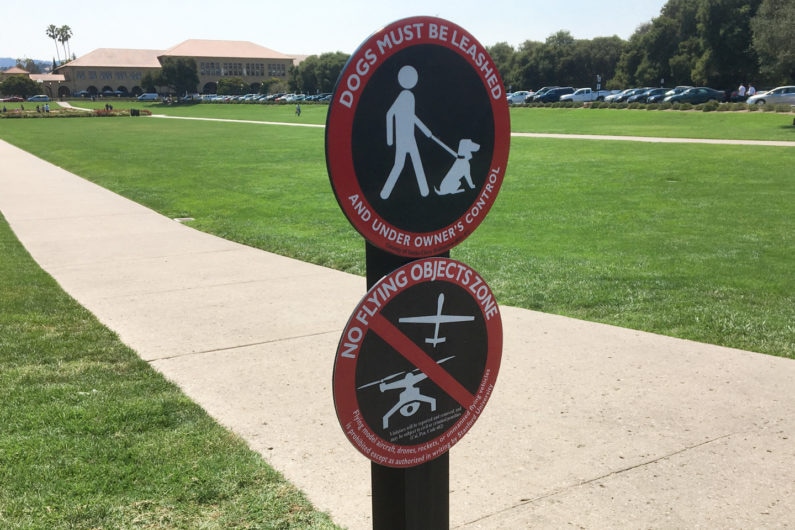Aug 30 2016
Unmanned flying vehicles (UFVs), such as drones, have become increasingly visible in parks and open spaces across America. Stanford faculty and students are among those working on the effective design and deployment of these aircraft.
 Signs going up at various locations around the campus, including the Oval, publicize Stanford’s rules for unmanned flying vehicles.(Credit: Stanford University)
Signs going up at various locations around the campus, including the Oval, publicize Stanford’s rules for unmanned flying vehicles.(Credit: Stanford University)
But UFV flights can pose safety and privacy risks in a campus environment such as Stanford’s. As a result, the university has enacted a new policy governing the use of UFVs at Stanford.
The policy prohibits third parties from outside the Stanford community from flying UFVs above or from within Stanford lands, which are private property. The policy also requires Stanford faculty, students and staff to obtain advance approval for a UFV flight at Stanford through a new university committee that has been established to serve as a single, streamlined resource for reviewing proposed flights.
The new protocols come out of a deliberative process that brought together stakeholders from across the university in recent months to formulate UFV guidelines for the campus. They also come as the Federal Aviation Administration has adopted new rules regarding private drone flights.
“We want to support the safe use of UFVs for university research, education and business purposes,” said Larry Gibbs, associate vice president for environmental health and safety. “We also want to provide a reasonable process that actively addresses the safety, regulatory compliance, risk management and privacy considerations that arise from UFV flights over Stanford lands. The policy seeks to do both.”
Among the challenges of unregulated UFV flights, drone flying in several parts of the campus poses a risk to the helicopters that bring critically injured patients to Stanford’s two hospitals. Tourists and hobbyists have flown UFVs in places such as the Main Quad in recent months, despite the many pedestrians and bicyclists passing by underneath and the presence of classrooms nearby. The crash of a remote-controlled model airplane also started a brush fire in the Lagunita lakebed in July 2015.
The new policy is contained in Chapter 7.10 of the Research Policy Handbook (RPH) on the Stanford DoResearch website, at doresearch.stanford.edu/ufvpolicy. Instructions for requesting review of a proposed UFV flight and an application form to initiate such a review are provided on the web page.
“This policy provides Stanford faculty and students with a single, coordinated approach for obtaining approval for UFV flights,” said Mykel Kochenderfer, assistant professor of aeronautics and astronautics. “Providing UFV airspace access will facilitate important research on campus involving a wide range of technologies important to infrastructure inspection, agricultural monitoring and various humanitarian applications.”
Under the policy, a proposed UFV flight submitted for approval must have a nexus to the university’s mission and must adhere to any limits prescribed by the review committee to ensure safety and compliance with applicable laws.
UFV flights generally will not be allowed in certain campus locations, such as the Oval, Main Quad, Memorial Court, Central Energy Facility, SLAC National Accelerator Laboratory, and near roads, highways, hospitals or public venues. Signs about Stanford’s UFV flight restrictions have been posted at some campus locations, and more are expected in the future.
As the regulatory and safety requirements surrounding UFV flights are complex, the policy applies not only to UFV flights at Stanford, but also to flights undertaken on behalf of the university at any other location. A UFV accident as part of a university activity can have significant consequences, no matter where it occurs.
Representatives from several campus entities will review proposed UFV flights for approval. The representatives include faculty and staff from the School of Engineering and the School of Humanities and Sciences; Dean of Research Office; Student Affairs; Risk Management; General Counsel; Public Safety; Land, Buildings & Real Estate; and Public Affairs.
Students who are members of a university-sanctioned hobbyist club will be able to fly model aircraft for recreational or hobby purposes in areas pre-approved for the hobbyist club, without going through the committee approval process for each individual flight.
Additional information and answers to questions about the policy may be found in RPH 7.10 in Section 7, “Submission and Contact Information.”